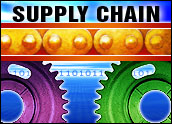
Over my 30-year career as a supply chain business process consultant, I’ve had the pleasure of working with some of the largest corporations in the world — so imagine my surprise when many of these companies told me that they were continuing to have problems with their supply chain.
Even more surprising was that most of their problems stemmed from a lack of visibility and the inability to predict the performance of their supply chain partners. It’s surprising because for the past 25 years, supply chain visibility has been the topic of conversation in many business articles, supply chain organizations, and analyst reports.
Manufacturers, retailers, distributors, and third-party logistics organizations focus on their ability to track the location of an order or shipment. While in-transit tracking is important for the obvious reasons, it is only the tip of the iceberg when it comes to supply chain visibility. Contained in these supply chain messages are a wealth of information that, used properly, can help a company reduce operational costs, increase revenues, and improve customer service.
Order to Cash and Procurement to Payment are key examples of processes that can leverage transactional data to drive economic performance, providing you capture the right information from all supply chain players within their respective life cycle.
The inability to utilize the nuggets of information contained in a supply chain information transaction can cause companies to maintain inordinate amounts of inventory to meet the pending demand of their customers. This can be especially true for companies that are trying to maintain perfect order performance, especially when their first line of sight to customer demand is the receipt of an order.
Understanding customer demand and buying trends are key to maintaining an economical supply chain. It can significantly reduce finished goods inventory levels, adding to more positive net income results.
The ability to utilize historical order information can provide tremendous insight into the buying trends of customers, especially if your customers lack the ability to provide accurate demand information. Armed with historical demand information, your organization is in a position to have a proactive relationship with customers, and it can forge a stronger partnership where both organizations improve their supply chain and overall profitability.
Demand-Driven Supply Chain Flows Both Ways
Think for a moment about what it would mean if you could predict demand — or at the very least, understand the buying trends of your customers. How would that information alter your finished goods inventory? How would that information change your production forecasting? By how much could you reduce operational costs if you had insight into customer buying trends?
The answer to these questions may vary from company to company, but with demand information your business is now positioned to financially benefit while improving customer relationships.
A demand-driven supply chain implies that the need for demand information works both ways. You need demand information from your customers, but your ability to provide demand information to your upstream partners is critical to overall supply chain success.
You cannot have a one-sided, demand-driven supply chain and expect to maximize supply chain benefits. This has been proven by manufacturing companies that have employed a Lean methodology. The ability to predict finished-goods demand, provide demand information, and synchronize these elements with operational forecasts is key to overall supply chain performance.
Utilizing supply chain information can provide tremendous insight into the performance of your supply chain partners, including suppliers, transportation vendors, and third-party logistics providers. Each of these supply chain partners plays a significant role in the success of your supply chain.
The ability to predict the performance of your partners can lead to reduced inventory levels, increased on-time delivery, and improved customer performance. Armed with this supplier information, you are positioned to reach out to your partners to improve performance and to provide a stronger, more successful relationship that can be economically advantageous to both parties. Without this information you cannot predict with any certainty whether you will have the necessary products or services to meet the demands on your business.
Cornerstone of a Well-Oiled Supply Chain
To capture the wealth of supply chain information contained in these electronic messages and turn them into performance-altering gems begins with the ability to monitor your supply chain in real- time. Managing volumes and activities associated with most supply chains requires immediate information. It is not enough to have information about today’s transactions tomorrow morning. It is too late to do anything about an order that went awry yesterday.
By the time you find out about this rogue order, the customer has become irate — and you will have expended tremendous resources and capital to fix the problem. Real-time issues require real-time solutions. To improve your visibility and the ability to address these issues means investing in technology that can manage your supply chain by quickly identifying problems as they happen — or better yet before they happen — and positively altering the outcome.
Real-time supply chain visibility is the cornerstone of a well-oiled supply chain. How great would it be to know the location of a shipment, order variances, production and inventory levels, and demand? The ability to predict success or failure is the difference between a successful supply chain and one that is in a reactive mode.
A reactive supply chain means that your SCM team will spend more time apologizing to customers and management for their failures, rather than driving process excellence and improving operation costs.
Utilizing software that contains business process infrastructure — coupled with the ability to monitor business activities on a platform that enables complete integration with internal and external information sources — can enable your business to reach the pinnacle of supply chain success.
This software needs to have the ability to analyze and predict supply chain outcomes on a real-time basis. This can be extremely important if your business supports customers who demand high performance through the use of a service level agreement. Knowing when an order is in jeopardy of breaching a service level agreement and being able to fix the problem before it becomes a financial liability can significantly improve bottom-line performance.
In addition, this software needs to have the capability and flexibility to support the various methodologies used by supply chain professionals and corporations, such as SCOR, Six Sigma, Lean and many others. It should be a technology that can capture real-time events and turn them into decision-supported actions that will improve overall performance and net income.
I cannot emphasize enough how critical it is to utilize technology as a part of your overall supply chain strategy. The global economy has taught us that the world is smaller than we think. The economic failures — while presumably isolated to a country or business sector — can have a dramatic effect on other countries or enterprises that appear to be totally distant or unrelated.
The ability to react to change, in any form, is key to the success of your business. And if you believe, as I do, that the supply chain is the epicenter of world commerce, then you would agree that having your finger on the pulse of this enormous giant of goods, services and information is a must for any enterprise that intends to be a player in the global economy.
Ralph B. Choppy is senior director of strategic solutions at Software AG.













































Social CRM
See all Social CRM